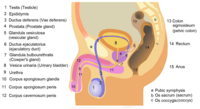
Photo from wikipedia
seminal tract may be injured and postoperative scar traction may occur, leading to recurrent local obstruction of the seminal tract, which may be the primary cause of the high rate… Click to show full abstract
seminal tract may be injured and postoperative scar traction may occur, leading to recurrent local obstruction of the seminal tract, which may be the primary cause of the high rate of postoperative recurrence. For these reasons, we performed a transurethral resection of the ejaculatory duct opening only when the prostatic utricle could not be found or the trans-window procedure failed. Unfortunately, there was no significant reduction in the incidence of complications. According to the anatomical data reported by Nguyen et al.,8 the normal size of the ejaculatory duct opening is only 0.3 ± 0.1 mm. The repeated stimulation of tissues that have chronic inflammation, congenital or acquired cystic lesions in the ejaculatory duct area, or other factors may lead to stenosis or atresia of the ejaculatory duct opening. In addition, poor semen excretion can also produce seminal tract stones and persistent chronic inflammation, and this situation makes it difficult to insert the endoscope via the natural pathway. In such situations, some scholars recommend using transurethral resection of the ejaculatory duct opening, and others recommend using the open-window procedure via the 5 and 7 o’clock points at the bottom of the prostatic utricle.9–11 At present, there is no uniform standard for this technique. The outer layer of the ejaculatory duct is longitudinal smooth muscle. At the proximal end, it becomes thin rapidly, and the inner smooth muscle disappears. Therefore, the ejaculatory duct has no sphincter functions, such as peristalsis or contraction, and urinary reflux is prevented only by the presence of the sharp angle between the ejaculatory duct and the prostatic urethra.12 An experiment in animals found that the relationship between the seminal vesicle and the ejaculatory duct was similar to that between the bladder and the urethra.13 When we make a hole to enter the ejaculatory duct, it is in theory a false channel; if the size of the hole is too large, it may result in reflux, and if the hole size is too small, it may induce recurrent stenosis or even occlusion after surgery.14 During our following surgeries, we used Storz F4.5–F6.5 ureteroscopes for patients with small ejaculatory duct openings and distorted or narrow seminal tracts, and we found that ultrathin ureteroscopes can pass smoothly into the ejaculatory duct. Therefore, we recommend these or similar endoscopes to increase the success rate and to minimize injuries to surrounding tissues. However, surgeons should be aware that TSV can still damage the seminal tract because of complex causes, such as the soft textures and distorted structures of the seminal colliculus, ejaculatory duct, and seminal vesicles. Accordingly, Dear Editor, We have read the article by Chen et al.1 with great interest. They reported the effect of transurethral seminal vesiculoscopy (TSV) for the treatment of recurrent hemospermia, and they concluded that TSV was an effective and safe procedure in the management of seminal tract disorders.1 TSV is an endoscopic technique that has developed rapidly in recent years. Because it is a relatively simple procedure and does not change the normal anatomical structures of seminal vesicles, this technique is becoming an alternative for the diagnosis and treatment of seminal vesicle and seminal tract diseases.2,3 Recently, we found that TSV is having a tendency to abuse in China. We have found that there have been issues with low qualification operator-related complications and failures in China recently. Some primary hospitals, even those have just settled ureteroscopy, have begun to plan a TSV surgery. Our department, as a Grade 3 hospital, has used TSV to treat 48 patients from January 2013 to July 2016. They were not able to locate the ejaculatory duct opening in some cases, which led to surgical failures. In addition, we have identified other complications, such as epididymitis, urinary tract infection, ejaculation abnormality, continuous hematuria, and rectal injury of clinical symptoms. The main reason may be related to the surgeon’s dependence on ureteroscopy, neglecting the uniqueness of TSV surgery. The anatomical structures may not be sufficiently visible during this kind of procedure, resulting in poor outcomes, relatively low spousal pregnancy rates, and postoperative complications rates of approximately 13%–26%.4 This procedure has the following disadvantages: (a) it may induce an injury to the rectum,5 and it may lead to retrograde ejaculation, caused by the destruction of the local antireflux mechanism,6 reflux seminal vesiculitis, or epididymitis; (b) after the normal structures and physiological functions of the ejaculatory duct and seminal vesicle are destroyed, the reserve function of the seminal vesicles decreases, the pH value of the semen changes, and the sperm motility and fertilization capacity decline; (c) the seminal vesicle fullness weakens and male sexual function decreases;7 and (d) when the endoscope is inserted via a nonnatural channel, the LETTER TO THE EDITOR
Journal Title: Asian Journal of Andrology
Year Published: 2019
Link to full text (if available)
Share on Social Media: Sign Up to like & get
recommendations!